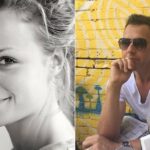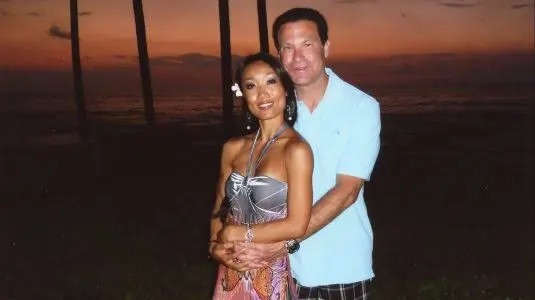
In July 2011, tragedy struck twice at the Spreckels Mansion in Coronado, California—a luxury seaside estate owned by wealthy pharmaceutical executive Jonah Shacknai. It began with a catastrophic fall that left six-year-old Max Shacknai, Jonah’s son from a previous marriage, gravely injured. Less than 72 hours later, Jonah’s girlfriend, 32-year-old Rebecca Zahau, was found hanging from a balcony inside the same mansion.
The question of what happened inside those walls—and why—has sparked a decade of speculation, investigation, and legal battles. Before unraveling the events of Rebecca Zahau’s death, it is necessary to understand the circumstances of Max’s fall.
At the time, Jonah was vacationing at Spreckels Mansion with Rebecca, who had invited her 13-year-old sister, Xena, to stay with them. Max, Jonah’s son with his ex-wife Dina Romano, was also there. According to friends and family, Max was a cautious, well-adjusted child, not prone to dangerous behavior. Reports described him as gentle and attentive—hardly the kind of child who would recklessly play near a balcony.
On the morning of July 11, 2011, Max somehow plunged over a second-floor banister and landed on the mansion’s first floor. He was found unconscious with severe injuries, including facial fractures and a spinal cord injury. A Razor scooter was found resting on his leg, and a nearby chandelier was broken. Soccer balls were scattered near the scene. There were no witnesses to the fall.
Rebecca told first responders she had been in a downstairs bathroom and heard either a loud crash or her dog barking. She claimed she found Max conscious and murmuring the word “Ocean,” the dog’s name. She called for her sister Xena, who had reportedly been showering upstairs, and told her to call 911. On the emergency call, Rebecca can be heard in the background shouting, “Don’t open that door!” as paramedics arrived at the home.
There were early questions about the consistency of Rebecca’s account. While she said Max was still conscious when she reached him, later medical assessments suggested the boy was already unresponsive by the time he arrived at Rady Children’s Hospital. A responding EMT later testified that he overheard Rebecca saying, “Dina is going to kill me,” while paramedics worked to stabilize the boy.
The cause of Max’s fall remained unclear. Investigators theorized that he may have been riding the scooter inside the house, lost control, and tumbled over the railing, possibly catching the chandelier on his way down. However, Max’s mother, Dina, disputed that version of events and launched a private investigation of her own.
She hired Exponent, a forensic consulting firm with experience in high-profile incidents. Dr. Robert Bove, one of their experts, concluded that Max’s center of gravity was too low for him to have gone over the railing along with the scooter. He also noted that the thick carpet in the hallway would have slowed the scooter’s speed, making such a fall unlikely. According to Bove, Max showed no injuries consistent with grabbing the chandelier during the fall, such as lacerations to the hands. Furthermore, the position of the scooter—resting directly on Max’s leg—appeared staged, not accidental.
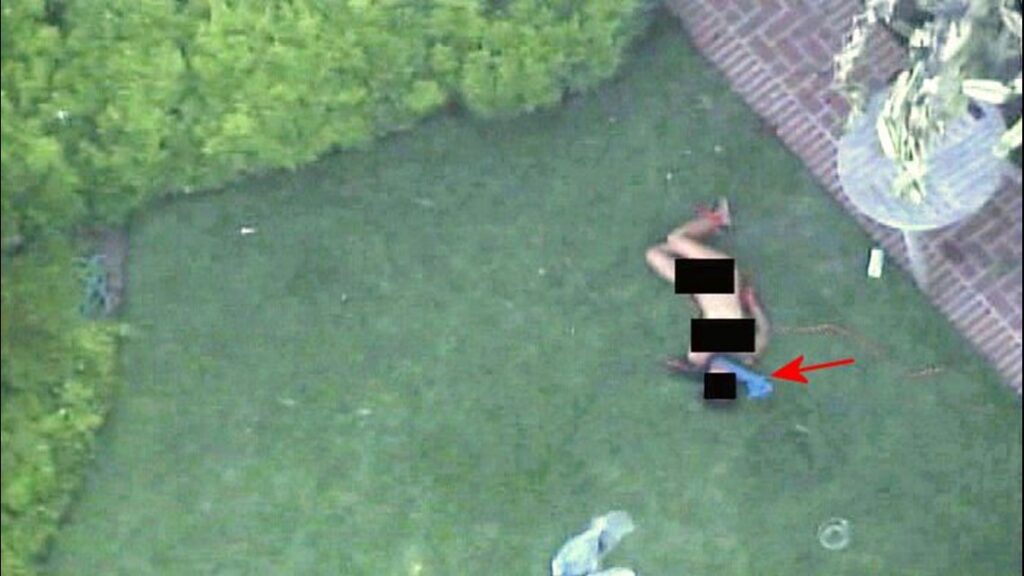
A forensic pathologist consulted by the family added that the location of Max’s spinal cord injury likely would have prevented him from speaking at all, contradicting Rebecca’s account that he had uttered “Ocean.” Despite these concerns, law enforcement officially ruled Max’s death a tragic accident, and no criminal charges were filed.
As Max lay in the ICU on life support, tensions among those closest to him began to surface. Rebecca had been tasked with picking up both Jonah’s brother Adam Shacknai and Jonah’s ex-sister-in-law, Nina Romano, from the airport on separate occasions. Nina would later say that Rebecca seemed evasive and acted oddly when asked about the circumstances of Max’s fall.
On the evening of July 12, 2011, Rebecca had dinner at the mansion with Jonah and Adam. Jonah returned to the hospital to be with his son. Adam stayed in the mansion’s guest house. According to his later statements, he took a sleeping pill and went to bed around 8 p.m.
By the next morning, July 13, just before 7 a.m., Adam Shacknai made a call to 911. He reported finding Rebecca Zahau dead in the courtyard of the Spreckels Mansion. She had been discovered hanging from the balcony of a guest room on the second floor.
She was completely naked. Her hands were bound behind her back, her feet tied together. A rope was wrapped tightly around her neck, the other end secured to a bedpost inside the room. There was also a message painted in black on the nearby door: cryptic, eerie, and unexplained.
What happened inside that house in the hours between dinner and dawn remains one of the most disturbing chapters in recent American true crime.
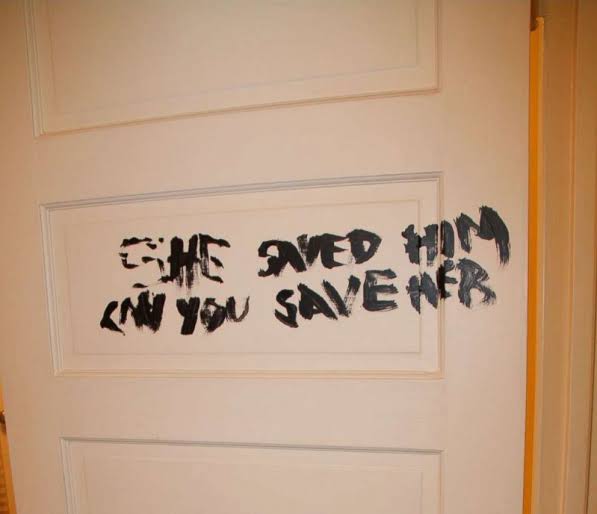
The Hanging at Spreckels Mansion
Just days after six-year-old Max Shacknai was hospitalized following his fall at the Spreckels Mansion, another emergency call came from the same property—this time reporting something even more disturbing.
On the morning of July 13, 2011, at approximately 6:48 a.m., Adam Shacknai, Jonah’s brother who had arrived in town the day before, called 911. He told the dispatcher that he had found Rebecca Zahau’s body hanging from the second-floor balcony of the main house. The description he gave was shocking. Rebecca was completely naked. A rope was wrapped around her neck and anchored to the foot of the bed in the guest room. Her hands were bound behind her back with a series of slipknots, and her feet were also tied. A long-sleeved T-shirt had been used as a gag, wrapped multiple times around her neck and stuffed into her mouth.
Adam later claimed he used a kitchen knife and a small patio table to reach her body. He said he cut her down and attempted CPR before calling authorities. On the 911 tape, he can be heard saying, “I got a girl, hung herself… same place you got the kid yesterday,” although Max had actually been taken to the hospital two days earlier.
When police arrived, they found Rebecca’s body lying in the courtyard below the balcony, with the rope still attached above and the knife and table nearby. The medical examiner would not arrive on the scene until over 12 hours later, drawing criticism for how long Rebecca’s body was left exposed.
Photos of the scene inside the guest room painted a strange picture. The red rope that had suspended her body was tied with a slip knot around the footboard of the bed. A plastic garbage bag, two paintbrushes, a tube of black paint, and two kitchen knives were scattered across the floor. The items were later catalogued in an official PowerPoint released by the San Diego Sheriff’s Department (SDSO).
One of the doors leading to the balcony bore a message written in black paint. Though authorities never publicly confirmed the exact wording, multiple sources, including Rebecca’s ex-husband and Ann Rule’s book Fatal Friends, Deadly Neighbors, have stated the words read: “She saved him, can you save her.”
The medical examiner, Dr. Jonathan Lucas, determined that Rebecca’s cause of death was suicide by hanging. He noted classic signs of death by asphyxiation, including petechial hemorrhages around the eyes and mouth, bruising on the strap muscles of the neck, and fractures of the hyoid bone and cartilage on the left side of her neck. The 9-foot drop from the balcony, he concluded, had been sufficient to cause death.
The autopsy also revealed scattered bruises and abrasions on Rebecca’s back, arms, and legs, which the medical examiner attributed to possible contact with surrounding foliage as her body fell at an angle rather than straight down. There were no drugs or alcohol in her system.
Her estimated time of death was around 3 a.m.
But many of the physical details left more questions than answers. The bindings on her hands and feet were made of the same red rope used around her neck. Police stated that her right hand could be slipped free from the knot and that the end of the rope was found in her hand, suggesting she may have tied the bindings herself. To support this possibility, investigators conducted a demonstration using a model with a similar build, showing that it was possible to tie the knots behind the back without assistance.
Still, several oddities remained. The rope was cut into three separate segments, implying premeditated effort. Black paint was found on Rebecca’s hands, torso, the rope, the paintbrush, and the tube of paint itself. The message on the door was written in block letters using that same black paint.
One of the most debated features of the scene was the lack of foreign DNA. Rebecca’s fingerprints and DNA were found on various items—the knives, the bed frame, the paint supplies—but none belonged to Adam Shacknai or anyone else. A child’s fingerprint (possibly Max’s) and one unidentified adult print were found on a part of the bed not connected to the hanging.
Cell phone records show that Rebecca was active until about 9:50 p.m. on July 12. She spoke to her sister in Missouri and reportedly made plans to visit later that fall. At 10:48 p.m., she received a text from Nina Romano, Dina’s twin sister, who wanted to stop by and talk about Max’s fall. Rebecca did not respond.
At 12:50 a.m., Rebecca listened to a voicemail that police were never able to recover. According to Jonah Shacknai, it was a message informing Rebecca that Max’s condition had worsened and he was unlikely to survive. The content of the voicemail, its timing, and the lack of police retrieval all became major points of controversy. Investigators waited over a month before powering on Rebecca’s phone, citing concerns about data loss due to the model being unfamiliar. By the time they accessed it, the voicemail had been deleted and was unrecoverable.
The condition of the balcony also raised further questions. Investigators noted only two barefoot impressions in the dust, consistent with bound feet standing still. An 11-inch area of disturbance was found on the railing, roughly the width of a human torso. Police concluded it matched what would be expected if Rebecca had leaned over it before falling.
Neighbors reported hearing a woman’s scream around 11:30 p.m. that night, but authorities dismissed the claim, saying the sound came from another direction. Another witness saw a heavyset woman with long dark hair walking near the mansion, but police said it was a relative trying to check on the family.
In the weeks that followed, SDSO leaned heavily on the idea that Rebecca was emotionally overwhelmed. They cited signs of insomnia and weight loss, and claimed she kept a journal on her phone showing signs of depression. According to Jonah Shacknai, she may have taken her life out of guilt, referencing her cultural background and what he described as “Asian honor.”
Rebecca’s family disputed this entirely. They maintained that she was a devout Christian who would not have died by suicide. There was no history of mental illness, no suicide note, and no prior attempts. They immediately began preparing to challenge the ruling in court.

Cracks in the Official Story
By the time San Diego Sheriff Bill Gore publicly declared Rebecca Zahau’s death a suicide, the media narrative had already begun to fracture. The image of a woman found naked, gagged, and bound, hanging from a balcony with a cryptic message painted nearby, did not sit easily with the public—or with Rebecca’s family.
Within days of her death, aerial photographs captured by news helicopters showed her body still lying in the courtyard of the Spreckels Mansion, stark and exposed. Online discussions exploded. A bizarre double tragedy had unfolded in the seaside mansion of a wealthy pharmaceutical CEO, and speculation spread quickly across television screens and message boards alike.
Rebecca Zahau’s family, however, made their position clear from the beginning. They did not believe she had taken her own life. Her sister, Mary Zahau-Loehner, spoke with reporters, stating unequivocally that Rebecca had plans for the next day, showed no signs of distress, and had never expressed suicidal thoughts. Their mother echoed the same: “We know for sure, she wouldn’t ever kill herself.”
When, just seven weeks later, the San Diego Sheriff’s Office (SDSO) announced it was closing the case and ruled her death a suicide by hanging, the family was blindsided. They accused investigators of rushing the process and ignoring evidence. Sheriff Gore’s office pushed back, noting that up to fifteen investigators and multiple crime lab specialists had worked full-time on the case for weeks. Initially, investigators themselves reportedly leaned toward the possibility of homicide, but ultimately, they said, the physical evidence pointed to suicide.
Still, the Zahau family did not accept that conclusion. They launched their own campaign to challenge the findings. A blog titled Justice for Rebecca Zahau was created by supporters and began documenting inconsistencies in the investigation. The family also contacted prominent Seattle attorney Anne Bremner, who reviewed the case and offered to represent them pro bono. Bremner’s legal network helped amplify the family’s concerns—and brought forensic experts into the spotlight.
Among them was Dr. Cyril Wecht, a renowned forensic pathologist known for working on high-profile cases, including the deaths of JonBenét Ramsey and President John F. Kennedy. In November 2011, Bremner, Wecht, and members of the Zahau family appeared on a two-part special of The Dr. Phil Show. The program funded the exhumation of Rebecca’s body, and Wecht conducted a second autopsy.
Though limited by embalming, Dr. Wecht raised significant doubts about the original findings. He agreed that Rebecca had suffered fractures to her hyoid bone and cricoid cartilage, as well as severe hemorrhaging in the neck muscles. These injuries, he explained, were not exclusive to hanging. They could just as easily indicate strangulation. Without clearer scene reconstruction or additional forensic analysis, the manner of death remained open to interpretation.
One detail stood out: Rebecca’s long hair had been tucked under the rope and gag. Bremner argued this was unusual. A woman with long hair would instinctively pull it free before placing something around her neck, she noted, unless someone else had done it for her.
The bindings themselves also raised suspicion. While police demonstrated that it was possible for someone to bind their own hands behind their back using slipknots and repositioning, skeptics argued that the complexity of the knots—described as cleat hitches, often used in nautical settings—suggested outside involvement. Some pointed to similarities between the bindings and Japanese Shibari rope art, a form of bondage, and questioned whether this detail linked back to computer searches allegedly made for “Asian bondage porn” on a device in the house. Rebecca’s family insisted she would never have explored such content.
Dr. Wecht also addressed another critical detail: subgaleal hemorrhages on Rebecca’s scalp. The original autopsy attributed these to contact with vegetation beneath the balcony. But Wecht suggested they were more consistent with blunt force trauma—potentially from a fist or other object—delivered while Rebecca was still alive. He believed such blows could have rendered her unconscious before she was hanged.
The distribution of lividity, or postmortem pooling of blood, also sparked debate. Rebecca had been estimated to have died around 3 a.m. and was discovered shortly before 7 a.m. Lividity had fixed in her back, not her legs. Critics questioned whether this was consistent with hanging or if it indicated her body had been staged after death. While experts disagreed on the implications, the inconsistency added fuel to the growing controversy.
Further details emerged: faint adhesive marks on her shins suggested that tape had once been applied to her legs. Yet no tape was found at the scene. Investigators attributed the marks to athletic tape Rebecca may have used during exercise. The family was not convinced.
There were also drops of blood on Rebecca’s inner thighs and in her vaginal cavity. The medical examiner attributed them to either menstruation or spotting from her IUD, and found no evidence of sexual trauma. Nonetheless, questions remained about whether her nudity and body position were consistent with suicide or if they reflected something more sinister.
For critics of the official narrative, the physical evidence alone was not enough. The investigative process itself came under fire. Reports suggested that a clump of hair and a drop of blood were found in a bathroom, yet never tested. A pair of women’s underwear was discovered in the guesthouse trash—where Adam Shacknai had stayed—but was not examined for DNA. Investigators explained that none of this appeared linked to Rebecca’s death and did not warrant further analysis.
Dr. Maurice Godwin, another forensic analyst brought in by the family, examined photographs of the balcony and concluded that at least one unidentified shoeprint overlapped Rebecca’s footprints. He interpreted this as evidence that another person had been present on the balcony during the critical window. Godwin also questioned the movement of the bed, to which the rope was tied. He argued that the 7.5-inch shift was inconsistent with the momentum that should have been generated by Rebecca’s body going over the railing. A reenactment by CBS8, a local news station, suggested that a much larger displacement—closer to three feet—should have occurred.
The debate over pornography access added yet another layer of unease. Attorney Anne Bremner told News 8 that search terms such as “raped Asian girls” and “bondage anime” were accessed on a mansion computer the night before Rebecca’s death. The Sheriff’s Department claimed this activity was the result of automated updates and cookies. They also noted that Adam Shacknai admitted to watching pornography on his phone the morning he found Rebecca.
Rebecca’s religious background and modesty were cited by family members as reasons she would never die by suicide, let alone in the nude. Her mother and sisters insisted that the manner in which she was found—naked, bound, gagged—was completely out of character. Still, police maintained that she may have been emotionally distraught over Max’s worsening condition and had taken her life out of overwhelming guilt.
With official channels stalled, the family turned to the courts. In 2013, the Zahau family filed a wrongful death lawsuit, alleging Rebecca had been murdered. Though the case would evolve over the years, the initial complaint named Adam Shacknai, Jonah’s ex-wife Dina, and her sister Nina Romano as parties involved in a conspiracy.
As public pressure grew, so did the demands for a second look at the evidence. The case was far from over.
The Case Goes to Court
In the years following Rebecca Zahau’s death, what began as a public mystery slowly evolved into a legal battle. Despite the San Diego Sheriff’s Office (SDSO) closing the investigation in 2011 with a suicide ruling, the Zahau family was determined to press forward. They were convinced Rebecca had been murdered, and the courtroom became their next battleground.
Public skepticism had never faded. Rebecca’s death captured national attention almost immediately. Within hours of Adam Shacknai’s 911 call, news helicopters hovered above the Spreckels Mansion, broadcasting footage of Rebecca’s body lying in the courtyard. The strange scene—nude, bound, gagged, hanging from a balcony with a cryptic message nearby—did not look like a suicide to many observers. Online forums and blogs dissected every detail, from the bed frame movement to the knot patterns in the rope. Theories quickly emerged.
One of the most widely circulated theories suggested that Rebecca had been attacked by Adam Shacknai, possibly with the help of Jonah’s ex-wife, Dina Shacknai, and her twin sister, Nina Romano. Some speculated the three had confronted Rebecca about Max’s accident. Others imagined a violent altercation spiraling into murder, followed by an elaborate staging to disguise it as suicide. At the center of every version was Rebecca, silenced in death, and a question that refused to go away: who had something to gain?
The Zahau family, led publicly by Rebecca’s sister Mary, channeled their grief into action. By 2013, they had filed a wrongful death lawsuit naming Adam, Dina, and Nina as defendants. The suit alleged that all three had conspired to murder Rebecca and cover up the crime. It laid out a theory in which Rebecca was struck on the head and rendered unconscious, then tied, gagged, and thrown from the balcony by the trio. The message on the door, according to the family’s attorneys, had been part of the staging.
But the case began to unravel. Surveillance footage showed that Dina had spent the entire night of July 12 at Rady Children’s Hospital, by her son’s side. Nina admitted visiting the mansion that night but claimed she left when no one answered the door. Cell phone records and lack of physical evidence corroborated her story. Jonah Shacknai was never a suspect and had verifiable proof he remained at the Ronald McDonald House that night. Rebecca’s ex-husband was also cleared, having been in Arizona.
By 2017, both Dina and Nina were officially dismissed from the lawsuit. In an unusual move, Zahau family attorney Keith Greer issued a public apology, stating their inclusion in the case had been “flat-out wrong.” The lawsuit would move forward with only one remaining defendant: Adam Shacknai.
The civil trial began on February 28, 2018. Unlike a criminal trial, the burden of proof in a civil case is lower. Jurors needed only to determine that it was more likely than not that Adam was responsible for Rebecca’s death. No prison sentence would result, but monetary damages and, perhaps more importantly, public accountability were on the table.
Twelve jurors—six men and six women—were tasked with evaluating a deeply complicated case. Attorney Keith Greer represented the Zahau family. Adam’s defense was led by high-profile lawyer Dan Webb.
The trial revisited the most controversial pieces of evidence. Rebecca’s blood had been found on a steak knife in the bedroom where her body was discovered. No visible wounds explained it. The defense attributed the presence of blood to menstruation. Greer introduced a darker possibility: that the knife had been used in a sexual assault, though both autopsies had found no physical signs of trauma.
The rope bindings were also scrutinized. A forensic knot analyst demonstrated how someone could hog-tie another person using the same knot types seen on Rebecca. He concluded the bindings were consistent with restraint by another individual. Yet under cross-examination, he admitted the knots were simple, common, and could not be definitively linked to Adam or to any specific person.
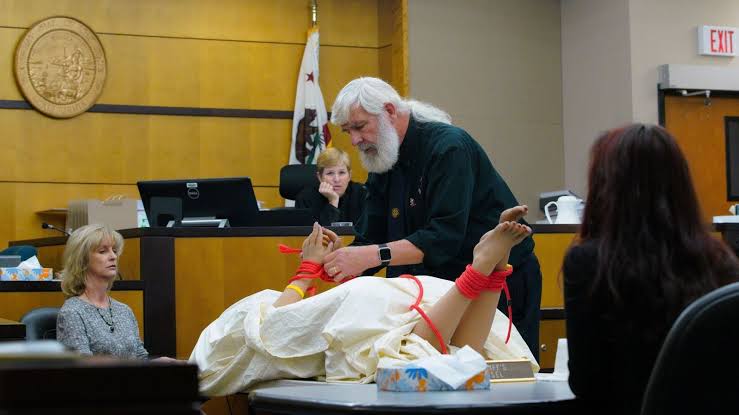
Handwriting experts were called to weigh in on the painted message—”She saved him, can you save her.” A comparison with samples from Adam and Rebecca led one expert to state it was more likely Adam had painted the message. Still, he acknowledged the limitations of block-letter analysis and could not offer a conclusive identification.
Fingerprints and DNA told their own story. Adam’s were nowhere at the scene. Not on the knives, the rope, the bed, or the balcony door. Greer argued this showed intentional wiping. The defense argued it showed innocence.
Testimony from family members furthered both sides. Rebecca’s mother and sister repeated what they had always believed: Rebecca was a woman of strong faith and would never have taken her own life. Under cross-examination, however, Rebecca’s mother admitted she was unaware of many details about her daughter’s recent life, including her job history and marital struggles.
Xena Zahau, Rebecca’s younger sister, also gave a recorded deposition. She recalled Rebecca screaming for her to call 911 after Max’s fall. She described the scene in detail: Max on the floor, the shattered chandelier, the Razor scooter, and the family dog running through the room. She saw no indication that Rebecca had harmed Max, which added further tension to the theory that guilt alone could have motivated a suicide.
In his defense, Adam Shacknai denied any involvement. He maintained that he had taken a sleeping pill at 8 p.m., gone to bed in the guesthouse, and woken up to find Rebecca’s body the next morning. He cut her down and called 911. His lawyers emphasized the total absence of forensic evidence linking him to her death. They pointed to the Sheriff’s Office’s original conclusion, the autopsy, and the demonstrations showing how the bindings could be self-inflicted.
Yet public opinion remained split. Some saw a rushed police investigation. Others saw a grieving family unwilling to accept tragedy. The court had to determine whether the story of Rebecca Zahau’s death would remain as it was written by law enforcement—or be rewritten by a jury of her peers.
The Civil Verdict That Changed the Narrative
In the years following Rebecca Zahau’s death, her family remained adamant that the official ruling of suicide was wrong. They believed the case had never been thoroughly investigated, and that Rebecca’s death was, in fact, a homicide. In 2013, they filed a wrongful death lawsuit against Adam Shacknai, the man who reported finding Rebecca’s body at the Spreckels Mansion.
Adam, the younger brother of Jonah Shacknai, was staying in the mansion’s guest house the night Rebecca died. His 911 call at 6:48 AM on July 13, 2011, brought law enforcement to a disturbing scene—Rebecca found nude, bound, and hanging from a second-story balcony. The San Diego Sheriff’s Department had ruled it a suicide. The Zahau family never accepted that conclusion.
The lawsuit alleged that Adam Shacknai had been motivated by anger over Max Shacknai’s accident—an incident that had occurred two days prior while Rebecca was supervising the boy. The family claimed that Adam had confronted Rebecca, assaulted her, and staged the scene to appear like a suicide.
In March 2018, nearly seven years after Rebecca’s death, the case finally went to trial in San Diego civil court. Unlike a criminal trial, which requires proof beyond a reasonable doubt, the burden in civil court was lower: a preponderance of evidence.
The Zahau family was represented by attorney C. Keith Greer, who argued that Rebecca’s death had all the hallmarks of a staged crime scene. He presented testimony from forensic experts and pointed out the complexity of the bindings around Rebecca’s wrists and ankles, the positioning of the gag, the presence of blunt force trauma to her head, and the black paint scrawled on the bedroom door reading, “She saved him, can you save her.” These elements, Greer contended, pointed to homicide, not suicide.
The defense maintained that Adam Shacknai had no motive and no opportunity to commit the crime. His legal team argued that police investigators had already determined the death was self-inflicted, based on scene reconstruction, autopsy results, and lack of conclusive physical evidence linking Adam to any assault. They pointed out that Rebecca had searched for suicide methods in the days prior to her death and suggested she was distraught over Max’s injuries and the possibility that he might die.
As the trial progressed, the jury heard weeks of testimony. The Zahau family’s expert witnesses challenged the official findings, claiming that it was implausible for Rebecca to have inflicted such injuries on herself or tied herself in such a manner before jumping from the balcony. The defense countered with their own expert interpretations, asserting that Rebecca’s bindings were feasible to self-administer and that her head injuries could have occurred during the fall.
In April 2018, the jury returned its verdict. By a vote of 9 to 3—enough for a civil case—they found Adam Shacknai responsible for Rebecca Zahau’s death. He was ordered to pay the family $5 million in damages. The courtroom was stunned. After years of insisting that Rebecca had taken her own life, the court had ruled otherwise.
Adam Shacknai immediately filed an appeal. His legal team argued that the trial had been unfair, claiming that expert testimony had been improperly admitted and that critical evidence had been misrepresented. But before the appeal process advanced, both parties reached a confidential settlement. The Zahau family agreed to vacate the $5 million judgment in exchange for undisclosed terms.
Although the settlement vacated the financial judgment, it did not overturn the jury’s finding. Adam Shacknai remained legally responsible for Rebecca Zahau’s death in the civil record. The family regarded the outcome as a partial victory, a public affirmation that Rebecca had not taken her own life.
Even so, the civil verdict did not trigger a reopening of the criminal case. In 2019, after reviewing the new developments, the San Diego County Sheriff’s Department reiterated its original position: that Rebecca Zahau had died by suicide, and that no criminal charges would be filed against anyone involved.
The official record remains unchanged, but public opinion has shifted. The civil trial brought national attention back to the details of the case. Advocates for Rebecca Zahau continue to call for a new investigation. The Zahau family still seeks accountability.
The Spreckels Mansion, now remodeled and sold to a new owner, no longer bears the immediate trace of the events that unfolded there. But the questions remain. How did a young woman end up hanged, bound, and naked from a balcony just days after a tragic accident involving her boyfriend’s child? Why did the message on the door appear to speak in riddles? And what really happened during the final hours of July 12, 2011?




